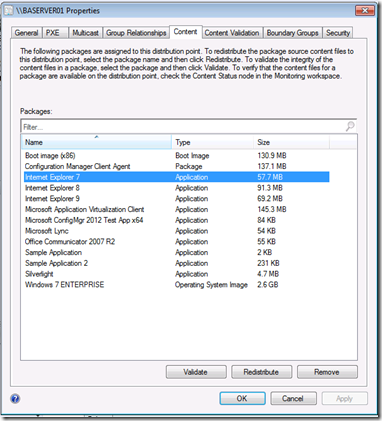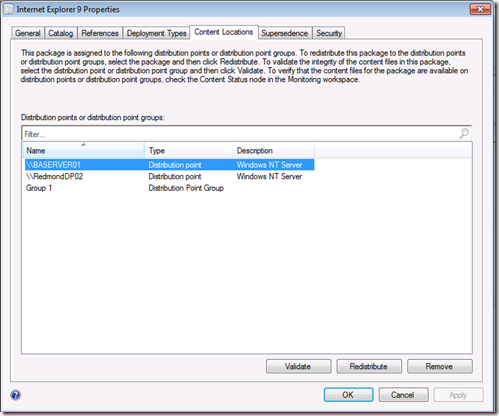Configuration Manager 2012: Content Management
As we have stated, simplified administration is a key pillar in the Configuration Manager 2012 release. Continuing down the path of simplicity, lets talk about some changes to managing content in your infrastructure. In this post we are going to cover the Distribution Point Groups, the new content distribution experience and alternate ways to manage content deployed through the infrastructure. We will cover monitoring the compliance of content and a new feature to validate content in the Configuration Manager 2012 infrastructure in our next post.
Why are we talking about all these content changes on an operating system blog? Because knowing and understanding content is critical to software and operating system deployment in Configuration Manager. So let’s get started.
Distribution Point Groups: In Configuration Manager 2007, there was a concept of Distribution Point groups. It was a basic way to group Distribution points and to easily target content. The group was used for targeting content to multiple distribution points, but there was no way to key the intent of the content distributed to the group. Let’s go over the changes to distribution point group starting with Configuration Manager 2012. The first change you will see is they are elevated to a top level in the Administration workspace. We have implemented state based distribution point groups. There is a new easy workflow from creating and managing the groups. A Distribution Point can also be a member of one or many groups. Next, groups are securable object. If you have looked into our Role Based Administration feature, you will learn you can limit access to objects through the use of scopes. So if you have an Administrator that just needs to manage content on all the distribution points in Redmond, WA, you can create a group of those distribution points and assign them the scope.
As I mentioned Distribution Point groups are state based. This means that if you target an Application, for example Microsoft Office, to a Distribution Group and then add a new distribution point to that group the new distribution point will automatically be distributed Microsoft Office. We also will offer reporting on the state of the content on the distribution points. So if you happen to remove content from a distribution point in a group, you can see the missing packages. We will also offer an ability in the SDK to redistribute the missing packages to the affected distribution points.
Distribution Point groups also offer the ability to associate a collection. With the collection association on the distribution point group, you can map the intent of the content to the actual distribution. So if all Program Managers are in Redmond you can link you Program Managers collection to Redmond Distribution Point group. Then distribute content with the intent of Program Managers being able to access the content for software installations. You can even automatically distribute content during Software Deployment.
Distribute Content: In Configuration Manager 2007 we had the Manage Distribution Point wizard which allows you to copy one package to many distribution points. We also had the Copy Packages wizard which allowed an administrator the ability to copy many packages to one distribution point. Starting with Configuration Manager 2012 we have removed these options and replaced them with the Distribute Content wizard. The Distribute Content wizard allows for the distribution of one to many packages (packages meaning Applications, Driver package, Boot Images, any content object) to one or many of any of the following: Distribution Points, Distribution Point Groups, or Collections associated with Distribution Point Groups. Another feature of the Distribute Content wizard is the ability to automatically detect associated dependencies and add them to the distribution for Applications. You can even select on to many task sequences, let Configuration Manager detect all related content associated and add them to a distribution. This is a great way to ensure you do not get Content not found for complex (or well even simple) task sequences.
As mentioned before we replaced the Manage Distribution Point wizard that was present in Configuration Manager 2007, but we only spoke to how to get content to the distribution point. How to I redistribute or remove content from Distribution Points or Groups
Managing Content: In Configuration Manager 2012, we provide various ways to see and manage the content distributed. First we can select a package and go to the properties page. From there we have a new tab called Content Locations. This shows us all the Distribution Points and Groups the content that has been assigned. We can select a Distribution Point or group and perform an action to either a remove the content or redistribute (formerly refresh the package action) the content to the selected Distribution Point or Group. Sounds good, but it not great if you need to remove multiple packages from a Distribution Point or Group. We have that covered as well. If you go to the properties of a Distribution Point or Distribution Point Group you will have a new Content tab. The Content tab will contain all the packages assigned to the Distribution Point or Group. From here we have the same ability to remove or redistribute a package from the Distribution Point or Group.
(Illustration below: The first picture is a Distribution Point properties page. It shows the assigned content and actions we can perform. The second picture is on the an Application property page. It shows the Content Locations tab and available actions.)
So this was a look at Distributing and Managing content in Configuration Manager 2012. Some key takeaways:
- Understanding Distribution Point groups
- Learning new ways to send content to distribution points
- Learning new ways to manage content distributed to the infrastructure
I will be continuing the series on Configuration Manager 2012 discussing more features of content delivery and OSD functionality over the next days to weeks. The next blog will cover Monitoring and Validation of content distribution. Feel free to comment if you have a specific ask for more information on portions of this overview.
Additional Configuration Manager 2012 Information:
- Introduction to Configuration Manager 2012 - link
- What’s New in Configuration Manager 2012 - link
- Fundamentals of Configuration Manager 2012 - link
John Vintzel
Microsoft Corporation | Sr. Program Manager | System Center Configuration Manager | twitter: jvintzel
http://blogs.technet.com/b/inside_osd
The blog is own by some members of the System Center Configuration Manager product team. These postings are provided "AS IS" with no warranties, and confer no rights.
EDIT: Updated old references

